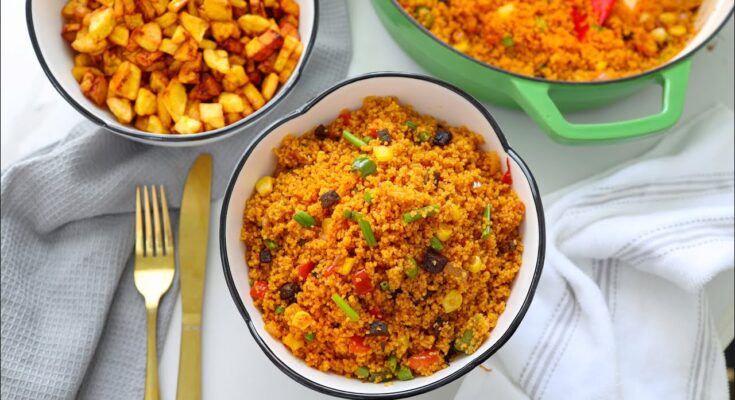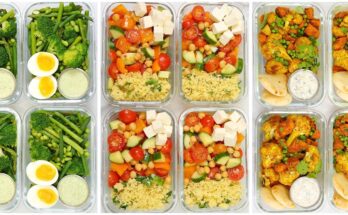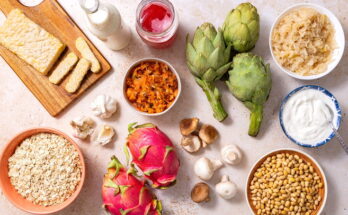Couscous Recipe: Couscous is a versatile and delicious dish that has earned its place in kitchens worldwide.
Whether you’re exploring North African cuisine or just looking for a quick, wholesome meal, couscous is the answer. It’s light, fluffy, and pairs beautifully with a variety of flavors.
This step-by-step guide will walk you through making perfect couscous, whether you’re a seasoned chef or a curious beginner.
Ingredients and Tools
Key Ingredients for Couscous:
- Couscous: 1 cup of traditional durum wheat couscous or a whole-wheat variety.
- Liquid: 1.5 cups of water, broth, or stock for added flavor.
- Salt: A pinch to enhance flavor.
- Butter or Olive Oil: 1 tablespoon for fluffiness and richness.
Optional Additions:
- Spices (e.g., cumin, turmeric, or paprika)
- Fresh herbs (e.g., parsley, cilantro, or mint)
- Nuts and dried fruits (e.g., almonds, raisins)
Essential Kitchen Tools:
- Medium-sized pot with a lid
- Fine-mesh sieve
- Fork for fluffing
- Optional: A steamer for traditional preparation
Step-by-Step Preparation of Couscous
1. Preparing the Ingredients
Start by gathering all the ingredients and tools. Measure the couscous and liquid, ensuring a 1:1.5 ratio for perfect hydration. If using spices, herbs, or broth, have them ready to go.
- Rinse the couscous lightly if desired, especially for bulk-purchased varieties.
- Boil the water or broth, adding salt and oil/butter to enhance the flavor.
2. Cooking the Couscous
There are two main methods for cooking couscous:
Quick-Cooking Method:
- In a pot, bring your liquid to a boil.
- Remove the pot from heat and stir in the couscous.
- Cover with a lid and let it sit for 5-10 minutes to absorb the liquid.
- Fluff with a fork to break up clumps.
Steaming Method (Traditional):
- Place the couscous in a steamer over boiling water.
- Let it steam for 10 minutes, fluffing occasionally to avoid clumping.
- Repeat steaming 2-3 times for extra fluffiness.
3. Adding Flavors
Infuse your couscous with bold flavors by cooking it in a seasoned broth. After cooking, stir in fresh herbs, toasted nuts, or dried fruits for a burst of texture and taste.
4. Pairing with a Sauce or Protein
Couscous is a blank canvas that pairs wonderfully with hearty vegetable stews, spiced meats, or grilled fish. Moroccan tagine or spiced chickpea stew makes excellent accompaniments.
5. Final Garnishes and Serving
Finish your dish with fresh herbs, a drizzle of olive oil, or a sprinkle of spices like smoked paprika. Serve warm for the best experience.
Tips for Perfect Couscous
1. Choosing the Right Type of Couscous:
There are various types of couscous, including Moroccan (small and fine), Israeli (pearl-like), and whole-wheat options. Choose one that fits your recipe and dietary needs.
2. Achieving Fluffy Couscous Every Time:
Always fluff couscous with a fork to keep it light and airy. Avoid over-mixing or using a spoon, which can make it dense.
3. Common Mistakes to Avoid:
- Using too much water can make couscous soggy. Stick to the recommended ratio.
- Skipping the fluffing step can lead to clumps.
- Forgetting to season your liquid results in bland couscous.
Variations and Regional Twists
1. Moroccan Couscous: Flavored with saffron, cinnamon, and sweet additions like raisins, it’s a festive and aromatic dish.
2. Tunisian Couscous: Often paired with a spicy tomato-based sauce and a mix of vegetables and meats like lamb or fish.
3. Gluten-Free and Whole-Wheat Options: Opt for corn or quinoa-based couscous for a gluten-free alternative. Whole-wheat couscous provides extra fiber and nutrients.
Nutritional Benefits of Couscous
1. Macronutrient Breakdown:
Couscous is primarily a carbohydrate, making it a quick energy source. A standard serving of couscous contains about 6 grams of protein, less than 1 gram of fat, and approximately 180 calories. This balanced macronutrient profile makes it a popular choice for meals.
2. Health Benefits of Ingredients:
- Durum Wheat Couscous: Rich in selenium, a powerful antioxidant that supports immune health and reduces inflammation.
- Whole-Wheat Couscous: Provides extra dietary fiber, which promotes digestive health and keeps you feeling full longer.
- Herbs and Spices: Ingredients like turmeric, parsley, and garlic can boost anti-inflammatory and antioxidant properties in your dish.
3. Serving Size and Calories:
One cup of cooked couscous is typically a single serving, offering roughly 180–200 calories depending on how it’s prepared. Adding nutrient-dense toppings, like vegetables or lean protein, ensures a well-rounded meal.
Serving Suggestions
1. What to Serve with Couscous:
Couscous is incredibly versatile and pairs beautifully with an array of dishes. Consider serving it alongside:
- Moroccan tagine with slow-cooked lamb and apricots.
- Mediterranean-style grilled chicken or fish.
- A hearty chickpea and vegetable stew.
2. Creating a Balanced Meal:
For a wholesome plate, combine couscous with:
- A lean protein like chicken, fish, or tofu.
- Roasted or sautéed vegetables such as zucchini, bell peppers, and eggplant.
- A healthy fat source, like avocado or tahini sauce.
3. Presentation Ideas:
- Use a small bowl or ramekin to mold the couscous into a neat dome shape before plating.
- Garnish with a sprig of parsley or a sprinkle of pomegranate seeds for a pop of color.
- Serve it family-style on a large platter with sauces and toppings arranged around the edges.
Storing and Reheating Couscous
1. Best Storage Practices:
- Store leftover couscous in an airtight container in the refrigerator.
- It stays fresh for up to 4-5 days.
2. Reheating Tips to Retain Texture:
- Sprinkle a few drops of water over the couscous before reheating to restore its moisture.
- Use a microwave or gently heat it on the stove over low heat, stirring occasionally.
- Avoid overcooking, which can make the grains mushy.
FAQs About Couscous Recipe
1. What is couscous?
Couscous is a traditional North African dish made from semolina flour rolled into tiny granules. It’s a versatile ingredient often used as a base for stews, salads, and side dishes.
2. How do I cook couscous perfectly?
To cook couscous, use a 1:1 ratio of couscous to boiling water or broth. Cover and let it sit for 5 minutes, then fluff with a fork for light and airy results.
3. Is couscous gluten-free?
No, couscous is not gluten-free as it’s made from wheat. However, gluten-free alternatives like corn or rice-based couscous are available.
4. Can I make couscous in advance?
Yes, you can prepare couscous ahead of time. Store it in an airtight container in the refrigerator for up to 3 days, and reheat with a splash of water or broth.
5. What dishes pair well with couscous?
Couscous pairs wonderfully with roasted vegetables, grilled meats, hearty stews, or as a base for fresh salads with lemon and herbs.
6. Can I customize the flavor of couscous?
Absolutely! Add spices, herbs, nuts, or dried fruits during cooking to enhance its flavor and make it unique to your taste.
Conclusion
Couscous is a culinary gem that offers endless possibilities in the kitchen. Whether you’re serving it as a side dish, using it as a base for a hearty stew, or creating a vibrant salad, couscous is as simple to prepare as it is delicious. With this step-by-step guide, you’ll be able to make fluffy, flavorful couscous every time and impress your family or guests with ease. Try experimenting with different variations to discover your favorite way to enjoy this versatile dish!



